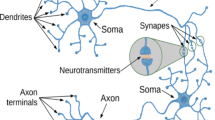Abstract
To study the physiology of the central nervous system it is necessary to understand the properties of the neural networks that integrate it and conform its functional substratum. Modeling and simulation of neural networks allow us to face this problem and consider it from the point of view of the analysis of activity correlation between pairs of neurons. In this paper, we define an optimized integrate-and-fire model of the simplest network possible, the monosynaptic circuit, and we raise the problem of searching for alternative non-monosynaptic circuits that generate monosynaptic-like correlated activity. For this purpose, we design an evolutionary algorithm with a crossover-with-speciation operator that works on populations of neural networks. The optimization of the neuronal model and the concurrent execution of the simulations allow us to efficiently cover the search space to finally obtain networks with monosynaptic-like correlated activity.
Access this chapter
Tax calculation will be finalised at checkout
Purchases are for personal use only
Preview
Unable to display preview. Download preview PDF.
Similar content being viewed by others
References
Alonso, J., Martínez, L.: Functional connectivity between simple cells and complex cells in cat striate cortex. Nat. Neurosci. 1, 95–403 (1998)
Alonso, J.M., Usrey, W.M., Reid, R.C.: Precisely correlated firing in cells of the lateral geniculate nucleus. Nature 383, 815–819 (1996)
Carpenter, G., Grossberg, S.: ART 2: Self-organization of stable category recognition codes for analog input patterns. Applied Optics 26, 4919–4930 (1987)
Deb, K., Spears, W.M.: Speciation methods. In: Bäck, T., Fogel, D.B., Michalewicz, Z. (eds.) Evolutionary Computation 2. Advanced algorithms and operators, ch. 4, pp. 93–100. Institute of Physics Publishing, Bristol, United Kingdom (2000)
Fetz, E., Gustafsson, B.: Relation between shapes of post-synaptic potentials and changes in firing probability of cat motoneurones. J. Physiol. 341, 387–410 (1983)
Gerstein, G., Perkel, D.: Mutual temporal relationships among neuronal spike trains. Statistic techniques for display and analysis. Biophys. J. 12, 453–473 (1972)
Goldberg, D.: Genetic algorithms in search, optimization and machine learning. Addison-Wesley, Reading (1989)
Hubel, D.H., Wiesel, T.N.: Receptive fields, binocular interaction and functional architecture in the cat’s visual cortex. J. Physiol (Lond.) 160, 106–154 (1962)
Jack, J., Nobel, D., Tsien, R.: Electric current flow in excitable cells. Oxford University Press, Oxford, United Kingdom, revised paperback (1983) edition (1975)
Kara, P., Reinagel, P., Reid, R.C.: Low response variability in simultaneously recorded retinal, thalamic, and cortical neurons. Neuron 27, 635–646 (2000)
Levick, W., Cleland, B., Dubin, M.: Lateral geniculate neurons of cat: retinal inputs and physiology. Invest. Ophthalmol. 11, 302–311 (1972)
Mastronarde, D.N.: Two clases of single-input X-cells in cat lateral geniculate nucleus. II. Retinal inputs and the generation of receptive-field properties. J. Neurophysiol. 57, 7757–7767 (1987)
Stein, R.: The frequency of nerve action potentials generated by applied currents. Proc. Roy. Soc. Lond. B 167, 64–86 (1967)
Surmeier, D., Weinberg, R.: The relationship between cross-correlation measures and underlying synaptic events. Brain Research 331(1), 180–184 (1985)
Usrey, W., Reppas, J., Reid, R.: Specificity and strength of retinogeniculate connections. J. Neurophysiol. 82, 3527–3540 (1999)
Veredas, F., Mesa, H.: Optimized synaptic conductance model for integrate-and-fire neurons. In: 10th IASTED International Conference Artificial Intelligence and Soft Computing, Palma de Mallorca, Spain, pp. 97–102 (August 2006)
Veredas, F., Vico, F., Alonso, J.: Factors determining the precision of the correlated firing generated by a monosynaptic connection in the cat visual pathway. J. Physiol. 567(3), 1057–1078 (2005)
Veredas, F., Vico, F., Alonso, J.: Evolving networks of integrate-and-fire neurons. Neurocomputing 69(13–15), 1561–1569 (2006)
Author information
Authors and Affiliations
Editor information
Rights and permissions
Copyright information
© 2007 Springer-Verlag Berlin Heidelberg
About this paper
Cite this paper
Mesa, H., Veredas, F.J. (2007). Integrate-and-Fire Neural Networks with Monosynaptic-Like Correlated Activity. In: de Sá, J.M., Alexandre, L.A., Duch, W., Mandic, D. (eds) Artificial Neural Networks – ICANN 2007. ICANN 2007. Lecture Notes in Computer Science, vol 4668. Springer, Berlin, Heidelberg. https://doi.org/10.1007/978-3-540-74690-4_55
Download citation
DOI: https://doi.org/10.1007/978-3-540-74690-4_55
Publisher Name: Springer, Berlin, Heidelberg
Print ISBN: 978-3-540-74689-8
Online ISBN: 978-3-540-74690-4
eBook Packages: Computer ScienceComputer Science (R0)




